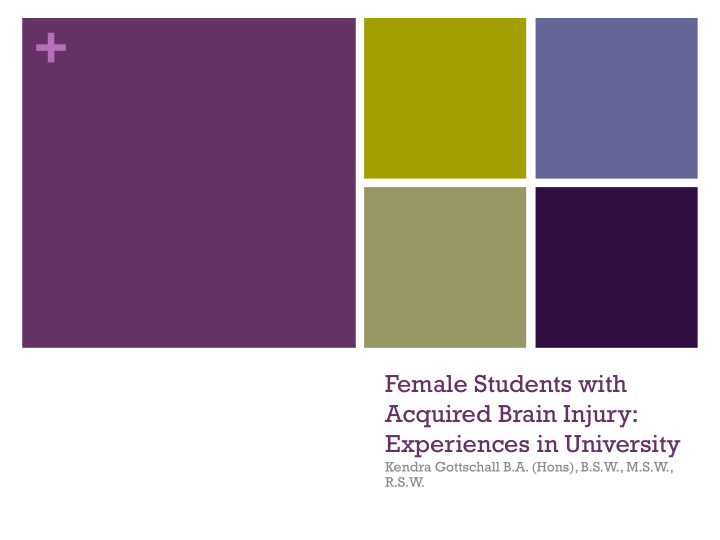



+ Female Students with Acquired Brain Injury: Experiences in University Kendra Gottschall B.A. (Hons), B.S.W ., M.S.W ., R.S.W .
+ “… it’s almost like being drunk. Like when you feel like you’re not in control of your body but in your head you’re able to think rational thoughts but it just doesn’t come out right all the time and you aren’t able to control your body…” -Adele
+ Introduction My personal experience How my identity as a person with an acquired brain injury impacted the research process
+ Research Question How has having an acquired brain injury impacted the experience of female students within postsecondary education?
+ Methodology Autoethnography is “…an approach to research and writing that seeks to describe and systematically analyze (graphy) personal experience (auto) to understand cultural experience (ethno)” (Ellis, Adams & Bochner, 2011, p. 1). “Researcher’s Journey” text boxes Journaling Narrative framework Semi-structured interviews
+ Recruitment and Sampling Name Approximate Time Postsecondary Elapsed Since Study Acquiring Brain Injury Jolene 1 year Graduate attempted- on leave due to injuries now Francine 8 years Undergraduate completed and enrolled in another program Lisa 6 years Undergraduate Adele 3 years Graduate Louise 7 years Undergraduate completed and enrolled in another program Researcher’s Reflection 8 years Graduate
+ Analysis of Participant’s Interviews “…from an academic standpoint, I just didn’t know what was out there… I knew if I had a broken leg, I knew I could get… accessible parking, but I had a broken brain. I didn’t know what to do with that.” – Adele
+ Analysis Cont’d “…I can’t relate to anybody there. I know that you know, every group… of people with (dis)Abilities would say the exact same thing and therefore it becomes really difficult to do that because there’s funding restrictions, but man wouldn’t it be nice if we lived in a world where, if I had a brain injury, I could go talk to somebody who had a brain injury and understood what I was saying.” - Jolene
+ Analysis Cont’d Impact of gender Helpful learning strategies: repetition, retaking courses, creative strategies Unhelpful learning strategies: comparing definitions, fill-in- the blank, lengthy papers, theoretical ideas, online learning system
+ Analysis: Supports Individual- connecting with doctor, use experience as a learning opportunity, develop capacity to think critically, remain optimistic Family and friends- identity impact Academic sphere- help from family members Professors- extensions, personal connections (dis)Ability resource centre- predetermined services- extra time, separate rooms, copies of notes Policy and procedures- student loan grants, spacing out classes
+ Analysis: Barriers Individual- preconceptions of others, weak, irrational emotions, belief injury self-inflicted Family and friends- view advantages as unfair, “falling behind” Professors- assumptions about recovery time Medical professionals- advice not practical/applicable to one’s reality (dis)Ability resource centres- services not tailored to brain injury specific needs, time of injury in academic career, centres don’t promote creative solutions
+ Analysis: Barriers Cont’d Policy and procedures- student loan, disclosing to potential employers Memory- organization/use of technology, informal techniques Stigma- sense of pride and self worth, others at different stage of coping- want to go back to “normal” Sociopolitical beliefs about asking from help- survivors seen as “tragic victims”, want to appear strong, got what I deserved, alone in dealing with this
+ Summary of Analysis Different ways of understanding brain injury= different accommodations needed Need for increased support in breaking down social isolation Differences in experiences impacts use of social supports More comprehensive services are needed
+ Practice Recommendations 1) Start “where the person is at” 2) Connect students with others with similar experiences 3) Work to address the broad social implications of brain injury- promote collaborative care 4) Advocate for amendments in policy 5) Assist in disclosing brain injury to others- benefits vs risks 6) Advocate for appropriate post-secondary accommodations
+ “… a train of thought for me is like a ball… this is the train of thought or concept that I want to talk about and then I read another post and suddenly there’s three other balls in my hands here and I have to remember which one of them was the first one that I wanted to talk about… there’s like another three or four or five balls there and then suddenly I have an entire room of balls and I’m trying to find that one and I can’t.” -Jolene
+ Conclusion and Next Steps Social workers should have a place in the academic environment Advocacy Work toward self-empowerment Obtaining appropriate accommodations Results can impact services provided by (dis)Ability resource centres Doctoral Research- Maritimes
Recommend
More recommend